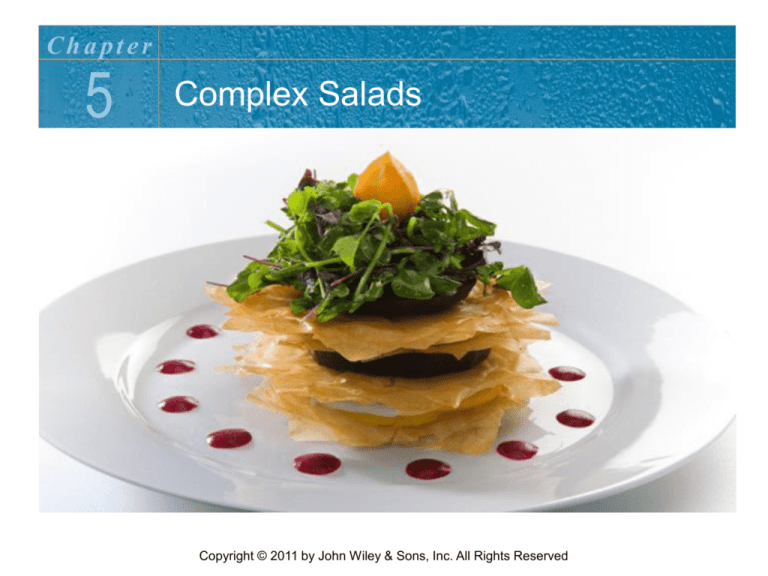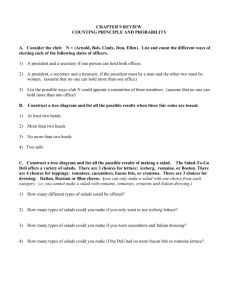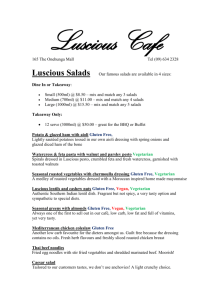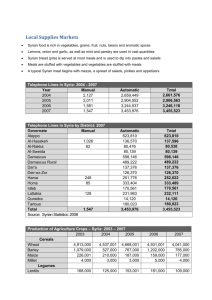
Chapter
5
Complex Salads
Copyright © 2011 by John Wiley & Sons, Inc. All Rights Reserved
Chapter
5
Complex Salads
Chapter Pre-Requisites
Before reading this chapter, you should already:
• Have read “How to Use This Book,” pages xxviii-xxxiii,
and understand the professional recipe format.
• Know how to perform basic meat, poultry, and seafood
preparation and cooking methods.
Copyright © 2011 by John Wiley & Sons, Inc. All Rights Reserved
Chapter
5
Complex Salads
Chapter Objectives
After reading this chapter, you should be able to:
• Explain the difference between simple salads and complex salads.
• Prepare each type of complex salad presented in this chapter in
accordance with food safety practices.
• Plate arranged salads in the bedded, mounded, flat, molded, and
stacked presentation styles.
• Use specialized garde manger tools to prepare contemporary
arranged salads.
• Create your own signature complex salads following the guidelines
given in the chapter.
Copyright © 2011 by John Wiley & Sons, Inc. All Rights Reserved
Chapter
5
Complex Salads
Understanding Complex Salads
• Salad is a broad term encompassing a variety of dishes,
making it difficult for chefs to agree on the correct way to
classify the various types.
• Among the many types, there are salads that are:
–
–
–
–
made up of raw or cooked vegetables or fruits
based on starches or legumes
based on protein foods
complex salads: a combination of the above three
Copyright © 2011 by John Wiley & Sons, Inc. All Rights Reserved
Chapter
5
Complex Salads
Understanding Complex Salads
Classifying by Presentation Style
• Mixed presentation
─ All ingredients are mixed together with
the dressing and mounded on a plate
or platter.
─ Sometimes, this type of salad is placed
on a lettuce liner leaf or on a bed of torn
or cut leafy greens.
─ Additional garnish elements may be
arranged on top.
Copyright © 2011 by John Wiley & Sons, Inc. All Rights Reserved
Chapter
5
Complex Salads
Understanding Complex Salads
Classifying by Presentation Style
• Arranged presentation
─ Each of the various elements is first
dressed or seasoned separately
─ They are then assembled together
on the plate in an attractive, artful
composition.
Copyright © 2011 by John Wiley & Sons, Inc. All Rights Reserved
Chapter
5
Complex Salads
Understanding Complex Salads
Classifying by Role in the Meal
• Complex salads can be categorized into several sub
classifications based on their traditional role in the meal.
1. Complex side salads: used as side dishes
Copyright © 2011 by John Wiley & Sons, Inc. All Rights Reserved
Chapter
5
Complex Salads
Understanding Complex Salads
Classifying by Role in the Meal
2. Bound protein salads: used at the center of plate or as
a sandwich filling.
Copyright © 2011 by John Wiley & Sons, Inc. All Rights Reserved
Chapter
5
Complex Salads
Understanding Complex Salads
Classifying by Role in the Meal
3. Complete salads (vegetable, starch, protein): used as
appetizers or entrées, depending on size.
Copyright © 2011 by John Wiley & Sons, Inc. All Rights Reserved
Chapter
5
Complex Salads
Understanding Complex Salads
Guidelines for Complex Salads Food Safety
• Wear food-service gloves, and be sure to change gloves
between tasks.
• Prevent cross-contamination by thoroughly sanitizing
your hands and all equipment before proceeding to
assemble a protein element (cooked or ready-to-eat)
with any raw ingredients and dressing.
Copyright © 2011 by John Wiley & Sons, Inc. All Rights Reserved
Chapter
5
Complex Salads
Understanding Complex Salads
Green Vegetables in Complex Salads
• Raw or cooked green vegetables that come into extended contact
with an acidic dressing:
– Lose their bright green color.
– Take on a less appealing olive drab color.
• To preserve the bright color of the green vegetables:
•
– Dress the salad just before service.
– Keep green vegetables separate from the other parts before mixing.
To infuse green vegetables with the flavor of the dressing:
– Mix the salad well ahead of time.
– Allow vegetables to absorb the dressing.
• Note: vegetables will discolor, but will also become very flavorful.
Copyright © 2011 by John Wiley & Sons, Inc. All Rights Reserved
Chapter
5
Complex Salads
Understanding Complex Salads
Onions in Complex Salads
• Raw onions are one of the most perishable ingredients in a complex
salad and deteriorate in a very short period.
• Within a day, or even hours, deteriorating raw onions can harm both
the texture and flavor of a complex salad.
– Most types of cut raw onions tend to water out and quickly acquire offflavors.
• Fabricate and add the onion component to each day’s batch at the
last minute before service.
Copyright © 2011 by John Wiley & Sons, Inc. All Rights Reserved
Chapter
5
Complex Salads
Understanding Complex Salads
Complex Side Salads
• Complex salads without a protein component are most often served
in small portions as a side dish.
• Serving cold foods and hot foods: when it is appropriate to serve a
complex salad as a side?
– In formal cuisine, hot accompaniments are served with hot foods and
cold accompaniments with cold foods.
– In formal dining, complex side salads should accompany only cold
entrées, such as cold roast meats and cold poached seafood.
– For this reason, they are traditionally served as part of cold buffets and
on cold entrée plates.
Copyright © 2011 by John Wiley & Sons, Inc. All Rights Reserved
Chapter
5
Complex Salads
Understanding Complex Salads
Complex Side Salads
• The four types of complex side salads are:
1. Raw vegetable side salads
• The crunchy texture and elemental flavor of raw vegetables make
them excellent side salad ingredients.
2. Cooked vegetable side salads
• Cooked vegetables make wonderful complex salads, provided they
are properly cooked before being combined with other salad
ingredients.
Copyright © 2011 by John Wiley & Sons, Inc. All Rights Reserved
Chapter
5
Complex Salads
Understanding Complex Salads
Complex Side Salads
• The four types of complex side salads are:
3. Pasta side salads
• The variety of pasta shapes, colors, and flavors available today allow
for an unlimited number of interesting and unusual pasta salads.
4. Grain and legume side salads
• Rice varieties, wild rice, wheat varieties, barley, buckwheat, quinoa,
corn products, dried beans and peas, and lentils can used for
delicious side salads.
Copyright © 2011 by John Wiley & Sons, Inc. All Rights Reserved
Chapter
5
Complex Salads
Understanding Complex Salads
Mellowing Time for Salads
• Most complex salads, especially starch-based salads,
have not yet achieved their best flavor and texture
immediately after preparation.
• Complex salads need time for:
– the solid ingredients to absorb some of the liquid ingredients.
– the flavors of all the ingredients to mix and mingle.
Copyright © 2011 by John Wiley & Sons, Inc. All Rights Reserved
Chapter
5
Complex Salads
Understanding Complex Salads
Safety Factors for Mayonnaise-Based Salads
• Starch salads (ex: potato) almost always taste better if the starch is
mixed with the dressing while the just-cooked starch is still warm.
– The starch absorbs more of the flavorful dressing.
• In a food-service setting, it is difficult to do this and still meet health
regulations for chilling to a safe temperature within the required time.
• If able to meet safety regulations for chilling foods, and to monitor
and log temperatures/times per batch, try mixing warm starches with
dressing before chilling.
Copyright © 2011 by John Wiley & Sons, Inc. All Rights Reserved
Chapter
5
Complex Salads
Understanding Complex Salads
Guidelines for Making Pasta Salads
• Boil pasta in a large amount of heavily salted, rapidly
boiling water, and cook to al dente texture.
• Do not add oil to the water
– This makes the surface of the pasta slick and prevents the
dressing from clinging to it.
• Avoid refreshing the pasta under running water.
– Doing so washes off the surface starch that causes the pasta to
cling to its sauce or dressing.
Copyright © 2011 by John Wiley & Sons, Inc. All Rights Reserved
Chapter
5
Complex Salads
Understanding Complex Salads
Guidelines for Making Pasta Salads
• Match the size and shape of the other ingredients to the
size and shape of the pasta, just as you would when
creating hot pasta dishes.
• Though it is thrifty to use leftover boiled pasta for pasta
salad, keep in mind that cold pasta does not absorb and
bind with dressing very well.
Copyright © 2011 by John Wiley & Sons, Inc. All Rights Reserved
Chapter
5
Complex Salads
Understanding Complex Salads
Guidelines for Making Grain and Legume Side Salads
• Cook grains and legumes for salads until they are tender, yet firm
enough so as not to disintegrate when mixed with dressing.
• While all have different cooking requirements, many grains and
legumes rely on carryover cooking to tenderize their interior starch
without splitting their exteriors.
• Pre-dress grains and legumes before they harden in the refrigerator.
– This will allow them to absorb flavorful liquids and prevent them from
drying out the finished salad.
Copyright © 2011 by John Wiley & Sons, Inc. All Rights Reserved
Chapter
5
Complex Salads
Understanding Complex Salads
Complex Main Course Salads
• Bound Protein Salads
– Made from diced or chopped meat, poultry, eggs, or seafood.
• Includes a small amount of vegetable ingredients and a thick dressing (ex:
mayonnaise).
– Referred to as “bound” because the thick dressing binds the main food
items together.
– Well-made bound salads, when picked up with a disher or portion
scoop, are firm enough to hold their shape on a plate.
– Bound protein salads (such as chicken, tuna, shrimp, and egg salads)
may be served as the centerpiece of a cold entrée plate, or used as a
sandwich filling.
Copyright © 2011 by John Wiley & Sons, Inc. All Rights Reserved
Chapter
5
Complex Salads
Understanding Complex Salads
Guidelines for Preparing Bound Protein Salads
• Cooked protein items should be fresh, moist, and tasty.
•
•
– While acceptable to recycle leftover cooked meats and poultry into
bound protein salads, check carefully for quality and freshness.
Keep accent vegetables to a minimum, and cut them very small.
– Customers perceive accent vegetables as filler, and consider a salad
with a high ratio of these to be of poor value.
Fabricate the protein item in a size appropriate for the salad’s intended use.
– For salads served as entrées, the item may be cut into fairly large dice.
– For sandwiches, the item should be chopped into small pieces.
Copyright © 2011 by John Wiley & Sons, Inc. All Rights Reserved
Chapter
5
Complex Salads
Understanding Complex Salads
Complete Salads in Mixed Presentation
• Complete salads are based on a protein item and
include substantial amounts of several vegetables, one
of which is often a starch.
– They are called “complete” because they offer all the elements of
a nutritionally balanced meal.
• Complex side salads (such as vegetable, pasta, grain,
and potato salads) may be transformed into complete
salads by adding a complementary protein item.
Copyright © 2011 by John Wiley & Sons, Inc. All Rights Reserved
Chapter
5
Complex Salads
Understanding Complex Salads
Fruit Salads may be presented either mixed or
arranged
• Casual mixed fruit salads are typically prepared ahead
of time, and are fast and easy to present.
• Arranged fruit salads are plated to order and, in many
ways, resemble a fruit platter.
– The difference:
• An arranged fruit salad is presented in its dressing.
• A fruit platter has no dressing, but may include sweet dips or side
sauces.
Copyright © 2011 by John Wiley & Sons, Inc. All Rights Reserved
Chapter
5
Complex Salads
Understanding Complex Salads
Guidelines for Preparing Mixed Fruit Salads
• Choose fruits with complementary flavors, textures, and colors.
• Fabricate fruits into pieces of the same general size, making sure
each piece will fit easily on a spoon.
– Fabricating fruits into many shapes creates visual interest.
• Create a theme by using mixtures of seasonal fruits, tropical fruits,
or specific types of fruit.
• Choose dressings that complement the fruit flavors. For example:
– Sweet fruits are best mixed with a tart, tangy dressing.
– Acidic fruits are best with a sweet dressing.
Copyright © 2011 by John Wiley & Sons, Inc. All Rights Reserved
Chapter
5
Complex Salads
Understanding Complex Salads
Guidelines for Preparing Mixed Fruit Salads
• Prepare fruit salads at the last possible minute before serving, as
fabricated fruits are highly perishable.
• If you must prepare fruit salads ahead of time, store under
refrigeration, and do not plan to hold them long.
• Fruits subject to softening and enzymatic browning should be held
out of bulk prepared salads and added just before serving.
– The same holds true for crisp or crunchy garnishes (such as toasted
nuts), which soften in contact with fruits and dressing.
Copyright © 2011 by John Wiley & Sons, Inc. All Rights Reserved
Chapter
5
Complex Salads
Understanding Arranged Salads
Arranged Salads
• A complex salad in
arranged presentation is a
complex salad consisting
of several separate food
elements placed on the
plate in a precise, planned
design.
Copyright © 2011 by John Wiley & Sons, Inc. All Rights Reserved
Chapter
5
Complex Salads
Understanding Arranged Salads
Elements of Arranged Salads
• An arranged salad has a minimum of three elements:
1. A main food item.
2. A secondary food item that is often a base, such as a liner leaf
or bed.
3. A garnish.
• Simple example: a scoop of chicken salad presented on
a lettuce leaf liner, and garnished with cherry tomato
halves.
Copyright © 2011 by John Wiley & Sons, Inc. All Rights Reserved
Chapter
5
Complex Salads
Understanding Arranged Salads
The Language of Plate Presentation
•
•
•
•
•
Plate rim: The raised outer edge of the plate that serves as the frame for
the composition created when the food is arranged on the plate.
Plate well: The main part of the plate inside the rim.
Front of the plate: The part of the plate intended for placement nearest to
the diner.
Back of the plate: The part of the plate intended for placement farthest
from the diner.
O’clock: A directive indicating a specific place on the plate’s perimeter that
corresponds to standard clock numerals.
– For example: 12 o’clock is at the back of the plate, while 6 o’clock is at
the front of the plate.
Copyright © 2011 by John Wiley & Sons, Inc. All Rights Reserved
Chapter
5
Complex Salads
Understanding Arranged Salads
Guidelines for Preparing Arranged Salads
• Present arranged salads on plates large enough to accommodate all
elements without crowding.
• Unusually shaped plates, such as squares and rectangles, can help
achieve a striking presentation.
• To ensure your presentation will be served intact, solidly construct all
food elements on the plate for easy transportation by tray/arm service.
• Make sure the customer can eat the salad neatly and easily without
much effort and attention.
Copyright © 2011 by John Wiley & Sons, Inc. All Rights Reserved
Chapter
5
Complex Salads
Understanding Arranged Salads
Guidelines for Preparing Arranged Salads
• Place sauces or garnishes away from the plate rim.
– The philosophy of plate presentation considers the plate rim the frame,
and the plate well the canvas.
• All the elements must complement each other, and all must serve a
purpose in the final synergy of the dish.
– For example: Do not add a particular element because of its color
without considering its flavor, texture, and general appropriateness to
the theme of the dish.
Copyright © 2011 by John Wiley & Sons, Inc. All Rights Reserved
Chapter
5
Complex Salads
Understanding Arranged Salads
Constructing the Plate
• Contemporary arranged salads may be classified into
the following five presentation styles:
1.
2.
3.
4.
5.
Bedded
Mounded
Flat
Molded
Stacked
Copyright © 2011 by John Wiley & Sons, Inc. All Rights Reserved
Chapter
5
Complex Salads
Understanding Arranged Salads
Bedded Presentations
• Among the most common
and traditional arranged
salads are those based on
a bed, or layer, of salad
greens.
Copyright © 2011 by John Wiley & Sons, Inc. All Rights Reserved
Chapter
5
Complex Salads
Understanding Arranged Salads
Mounded Presentations
• An assortment of complex
salads is arranged together on
a plate in separate piles.
• Be sure to choose salads that
are complementary in flavor
and work together to express a
theme.
• Consider the placement of
each item to create an
attractive combination of colors
and textures.
Copyright © 2011 by John Wiley & Sons, Inc. All Rights Reserved
Chapter
5
Complex Salads
Understanding Arranged Salads
Molded Presentations
• Molded salads may be composed
of virtually any ingredients, as
long as the ingredients are bound
with a sauce or dressing thick
enough to hold them in place once
the form is removed.
• During preparation, salads with
firm and relatively long-keeping
ingredients may be packed into
multi-unit forms.
Copyright © 2011 by John Wiley & Sons, Inc. All Rights Reserved
Chapter
5
Complex Salads
Understanding Arranged Salads
Stacked Presentations
• Large, flat pieces of food are stacked one on top of the other to
create a tower effect. These solid pieces may be cemented together
with bound protein salads, thick sauces, spreads, or mousses.
• To provide a crunchy element, crôutons, wafers, or pastry layers
may be included in the construction.
Copyright © 2011 by John Wiley & Sons, Inc. All Rights Reserved




